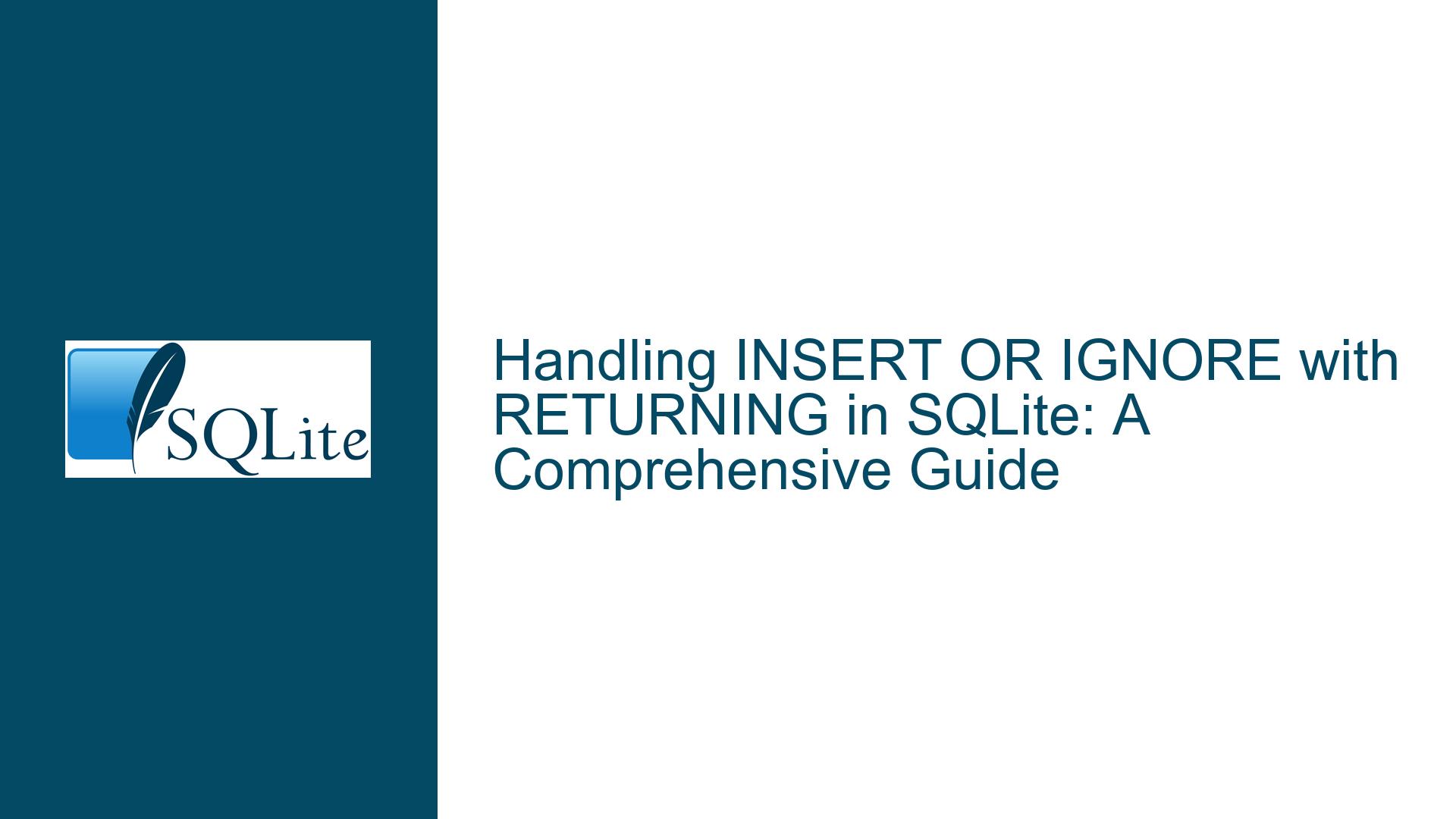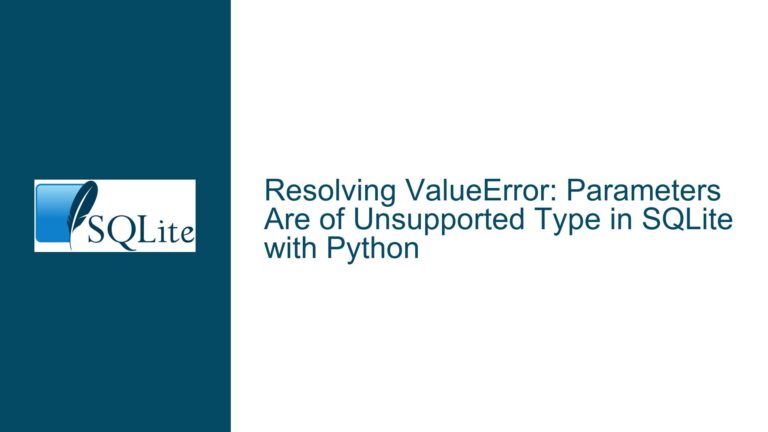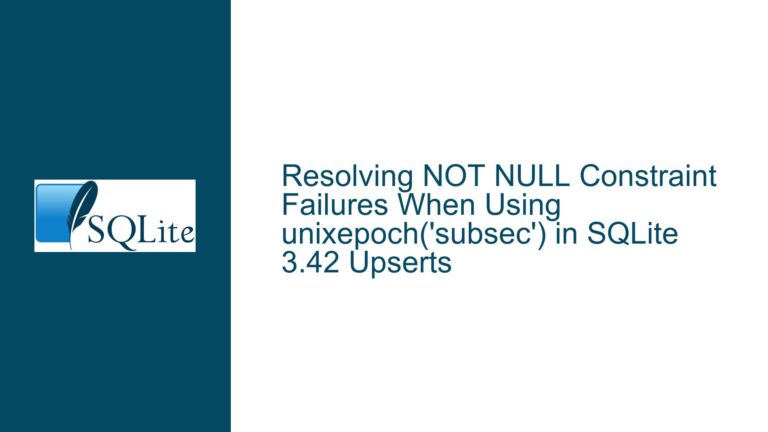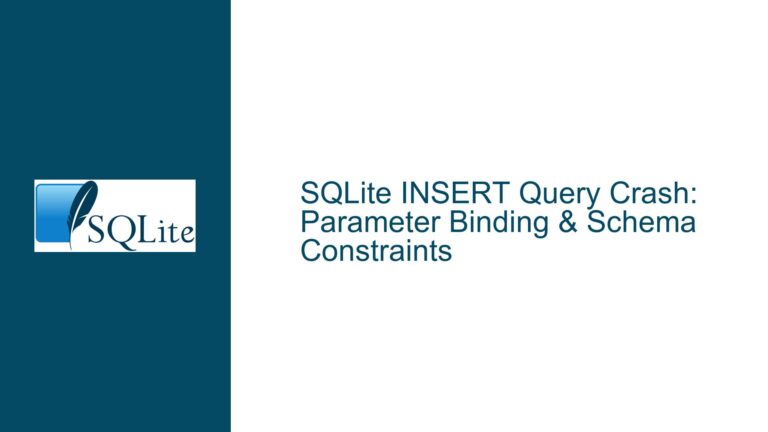Handling INSERT OR IGNORE with RETURNING in SQLite: A Comprehensive Guide
Issue Overview: INSERT OR IGNORE with RETURNING Clause in SQLite
When working with SQLite, a common requirement is to insert a new record into a table only if it does not already exist, while also retrieving the primary key (id) of the affected row, regardless of whether the insert operation was successful or ignored. This scenario often arises in applications where you need to ensure data uniqueness and simultaneously obtain the identifier of the record, whether it was just inserted or already present.
Consider a table t defined as follows:
CREATE TABLE t (id INTEGER PRIMARY KEY, title TEXT NOT NULL UNIQUE);
The goal is to insert a new title, such as 'foo', into the table t. If the title already exists, the insert operation should be ignored, but the id of the existing row should still be returned. The challenge lies in the fact that the RETURNING clause in SQLite does not return any values when the INSERT OR IGNORE statement results in no changes to the table (i.e., when the insert is ignored due to a uniqueness constraint).
For example:
sqlite> INSERT OR IGNORE INTO t (title) VALUES ('foo') RETURNING id;
id
--
1
sqlite> INSERT OR IGNORE INTO t (title) VALUES ('foo') RETURNING id;
In the second insert, the RETURNING clause does not produce any output because the insert operation was ignored. This behavior is problematic when you need to retrieve the id of the row that would have been affected, regardless of whether the insert was successful or ignored.
Possible Causes: Why RETURNING Fails with INSERT OR IGNORE
The core issue stems from the way SQLite handles the INSERT OR IGNORE statement in conjunction with the RETURNING clause. When an INSERT OR IGNORE operation is executed, SQLite attempts to insert the new row into the table. If a uniqueness constraint violation occurs (e.g., due to a duplicate title), the insert operation is silently ignored, and no changes are made to the table. Since no changes occur, the RETURNING clause has nothing to return, resulting in no output.
This behavior is by design, as the RETURNING clause is intended to return values from rows that were actually inserted, updated, or deleted. When an insert operation is ignored, no row is inserted, and thus, there is no row to return values from. This limitation can be particularly frustrating in scenarios where you need to obtain the id of the existing row that caused the insert to be ignored.
Another approach that might seem promising is using INSERT OR REPLACE, which replaces the existing row if a uniqueness constraint violation occurs. However, this approach has its own drawbacks. When INSERT OR REPLACE is used, the existing row is deleted and a new row is inserted, which results in a new id being assigned. This behavior is often undesirable, especially when you want to preserve the original id of the existing row.
For example:
sqlite> INSERT OR REPLACE INTO t (title) VALUES ('foo') RETURNING id;
id
--
2
In this case, the original row with id = 1 is deleted, and a new row with id = 2 is inserted. This behavior is not suitable when you need to maintain the original id of the existing row.
Troubleshooting Steps, Solutions & Fixes: Achieving INSERT OR IGNORE with RETURNING
To address the issue of retrieving the id of a row regardless of whether the insert operation was successful or ignored, we need to employ a combination of SQLite features and techniques. Below, we explore several solutions, each with its own advantages and trade-offs.
Solution 1: Using INSERT ... ON CONFLICT DO UPDATE SET
One effective solution is to use the INSERT ... ON CONFLICT DO UPDATE SET statement with a no-op update. This approach leverages SQLite’s conflict resolution mechanism to ensure that the RETURNING clause always returns a value, even when the insert operation is ignored due to a uniqueness constraint violation.
Here’s how it works:
INSERT INTO t (title) VALUES ('foo')
ON CONFLICT(title) DO UPDATE SET id = id
RETURNING id;
In this statement, the ON CONFLICT(title) DO UPDATE SET id = id clause specifies that if a conflict occurs on the title column, the id column should be updated to its current value (i.e., a no-op update). This ensures that the RETURNING clause is always executed, returning the id of the existing row when a conflict occurs.
For example:
sqlite> INSERT INTO t (title) VALUES ('foo') ON CONFLICT(title) DO UPDATE SET id = id RETURNING id;
id
--
1
sqlite> INSERT INTO t (title) VALUES ('foo') ON CONFLICT(title) DO UPDATE SET id = id RETURNING id;
id
--
1
In both cases, the id of the row with the title 'foo' is returned, regardless of whether the insert operation was successful or ignored.
Solution 2: Combining INSERT OR IGNORE with a Follow-up SELECT
Another approach is to first attempt the INSERT OR IGNORE operation and then immediately follow it with a SELECT statement to retrieve the id of the row. This method involves two separate SQL statements but achieves the desired outcome without modifying the table structure or using advanced conflict resolution techniques.
Here’s how it works:
INSERT OR IGNORE INTO t (title) VALUES ('foo');
SELECT id FROM t WHERE title = 'foo';
In this approach, the INSERT OR IGNORE statement attempts to insert the new row. If the insert is ignored due to a uniqueness constraint violation, the SELECT statement retrieves the id of the existing row with the specified title.
For example:
sqlite> INSERT OR IGNORE INTO t (title) VALUES ('foo');
sqlite> SELECT id FROM t WHERE title = 'foo';
id
--
1
sqlite> INSERT OR IGNORE INTO t (title) VALUES ('foo');
sqlite> SELECT id FROM t WHERE title = 'foo';
id
--
1
In both cases, the id of the row with the title 'foo' is retrieved, regardless of whether the insert operation was successful or ignored.
Solution 3: Using a Common Table Expression (CTE) for Atomic Operations
For scenarios where atomicity is critical, you can use a Common Table Expression (CTE) to combine the INSERT OR IGNORE and SELECT operations into a single atomic transaction. This approach ensures that both operations are executed as a single unit, preventing any intermediate changes to the table from affecting the outcome.
Here’s how it works:
WITH inserted AS (
INSERT OR IGNORE INTO t (title) VALUES ('foo')
RETURNING id
)
SELECT id FROM inserted
UNION ALL
SELECT id FROM t WHERE title = 'foo'
LIMIT 1;
In this CTE, the INSERT OR IGNORE statement is executed first, and its result (if any) is captured in the inserted CTE. The SELECT statement then retrieves the id from the inserted CTE if the insert was successful. If the insert was ignored, the SELECT statement retrieves the id from the table t where the title matches the specified value.
For example:
sqlite> WITH inserted AS (
INSERT OR IGNORE INTO t (title) VALUES ('foo')
RETURNING id
)
SELECT id FROM inserted
UNION ALL
SELECT id FROM t WHERE title = 'foo'
LIMIT 1;
id
--
1
sqlite> WITH inserted AS (
INSERT OR IGNORE INTO t (title) VALUES ('foo')
RETURNING id
)
SELECT id FROM inserted
UNION ALL
SELECT id FROM t WHERE title = 'foo'
LIMIT 1;
id
--
1
In both cases, the id of the row with the title 'foo' is retrieved, regardless of whether the insert operation was successful or ignored.
Solution 4: Using a Trigger to Capture the ID
For more complex scenarios, you can use a trigger to capture the id of the affected row and store it in a temporary table or variable. This approach involves creating a trigger that fires after an INSERT operation and stores the id of the newly inserted row in a temporary table. If the insert operation is ignored, the trigger does not fire, and you can retrieve the id from the main table.
Here’s how it works:
CREATE TEMPORARY TABLE temp_id (id INTEGER);
CREATE TRIGGER capture_id AFTER INSERT ON t
BEGIN
INSERT INTO temp_id (id) VALUES (NEW.id);
END;
INSERT OR IGNORE INTO t (title) VALUES ('foo');
SELECT id FROM temp_id
UNION ALL
SELECT id FROM t WHERE title = 'foo'
LIMIT 1;
DROP TRIGGER capture_id;
DROP TABLE temp_id;
In this approach, the capture_id trigger captures the id of the newly inserted row and stores it in the temp_id table. If the insert operation is ignored, the trigger does not fire, and the SELECT statement retrieves the id from the main table t.
For example:
sqlite> CREATE TEMPORARY TABLE temp_id (id INTEGER);
sqlite> CREATE TRIGGER capture_id AFTER INSERT ON t
BEGIN
INSERT INTO temp_id (id) VALUES (NEW.id);
END;
sqlite> INSERT OR IGNORE INTO t (title) VALUES ('foo');
sqlite> SELECT id FROM temp_id
UNION ALL
SELECT id FROM t WHERE title = 'foo'
LIMIT 1;
id
--
1
sqlite> INSERT OR IGNORE INTO t (title) VALUES ('foo');
sqlite> SELECT id FROM temp_id
UNION ALL
SELECT id FROM t WHERE title = 'foo'
LIMIT 1;
id
--
1
sqlite> DROP TRIGGER capture_id;
sqlite> DROP TABLE temp_id;
In both cases, the id of the row with the title 'foo' is retrieved, regardless of whether the insert operation was successful or ignored.
Conclusion
Handling INSERT OR IGNORE with the RETURNING clause in SQLite requires a nuanced understanding of SQLite’s conflict resolution mechanisms and query execution behavior. By employing techniques such as INSERT ... ON CONFLICT DO UPDATE SET, combining INSERT OR IGNORE with a follow-up SELECT, using Common Table Expressions (CTEs), or leveraging triggers, you can achieve the desired outcome of retrieving the id of the affected row, regardless of whether the insert operation was successful or ignored.
Each solution has its own advantages and trade-offs, and the choice of which to use depends on the specific requirements of your application. By carefully considering these options, you can ensure that your SQLite database operations are both efficient and reliable, even in the face of uniqueness constraints and other potential conflicts.






